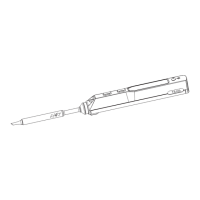
Do you have a question about the Mini TS100 and is the answer not in the manual?
| Brand | Mini |
|---|---|
| Model | TS100 |
| Category | Power Tool |
| Language | English |
General safety precautions for using the TS100, covering power source, environment, and cleaning.
Specifies operating and non-operating conditions for temperature and humidity requirements.
Critical warnings regarding unattended operation, tip temperature limits, and risk of electric shock.
Cautions on handling precision, handle surface temperature, and initial use smoke phenomenon.
Defines user liability for product damage caused by man-made actions or negligence.
Identifies and explains the physical ports and control elements on the TS100 soldering iron.
Provides detailed technical specifications including screen type, ports, dimensions, and weight.
Outlines operational specifications such as power output, temperature range, and stability.
Step-by-step guide for installing the soldering tip, ground wire, and connecting the power source.
Details the default settings for temperature unit, temperature, sleep mode, and adjustable range.
Introduces basic controls and explains the initial screen display sequence and DFU mode.
Instructions for entering and performing the automatic calibration mode using button presses.
Describes how to initiate heating to a preset temperature and recognize soldering readiness.
Details how to adjust temperature up or down, including holding buttons and saving settings.
Explains sleep mode activation, auto-temperature adjustment, and return to operation.
Details system parameters like standby/operating temps, wait/idle times, and step settings.
Instructions on how to unplug, loosen setscrew, replace, and tighten the soldering tip.
Presents different TS-series soldering iron tips (D24, K, BC2, B2) for selection.
Provides maintenance guidelines including wiping, avoiding high temps, cleaning, and flux usage.
Notes that tip lifespan depends on maintenance and usage intensity.
Troubleshooting steps for when the TS100 display shows no output.
Explains that random numbers on display after tip change indicate normal status checking.
Checks for proper power connection and low voltage issues causing automatic restarts.
Troubleshooting for simultaneous heating/cooling, checking tip use, power cord, overheating, and cleanliness.
Addresses 'Warning!' display, likely due to overheating or exceeding operation temperature.
Troubleshooting for 'High-Vt' display, indicating voltage is too high (over 24V).
Diagnoses 'Sen-err' display, suggesting improper tip installation or faulty tip.
Lists reasons for poor solder adhesion, including tip temp, oxidation, flux, and contamination.
Troubleshooting for unexpected standby mode, checking for low voltage conditions.
Details the one-year warranty policy and notes that tips are consumables.
Explains how to connect TS100 to PC via USB to enter 'CONFIG' mode and edit parameters.
Step-by-step guide for downloading firmware, entering DFU mode, and upgrading via USB.
Instructions on creating a custom boot-up screen by saving a BMP file as 'LOGOIN' on the USB drive.
Advises against disposing the product with domestic waste and to follow local regulations.
Confirms compliance with FCC regulations regarding interference generation and resistance.
States that the product with a CE logo complies with relevant Euro Union laws and regulations.